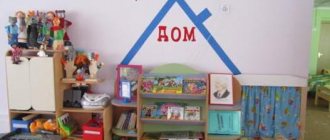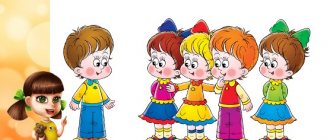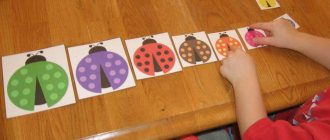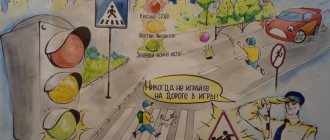Physical education and health activities in preschool educational institutions
Organization of physical education and recreational activities in preschools.
Physical education instructor at MDOU kindergarten No. 32
Kafidov Alexey Vladimirovich
Physical education and health activities are one of the forms of human activity that is aimed at developing a healthy personality. This type of activity is aimed at improving a person’s physical condition and health. Physical education and recreational activities occupy an important place in the field of educational and recreational activities in preschool educational institutions. Physical education and health activities are generally understood as consciously regulated motor activity of a person, aimed at developing and improving one’s own health and caring for it. The effectiveness of physical activity is associated with the formation of motivation for a healthy lifestyle, the acquisition of a certain level of knowledge and, of course, with the implementation of a person’s physical and health-improving activities.
The purpose of physical education and health work in preschool educational institutions is the development of basic motor actions, preparation for physical education at school, disease prevention and health promotion through physical education.
The main objectives of physical education and health work:
- maintaining physical and mental health;
- mastering basic motor actions;
- preparation for physical education at school;
- disease prevention;
- health promotion through physical culture
Physical education and health work in preschool educational institutions includes the following activities:
- physical activity,
- morning exercises,
- gymnastics after a nap,
- physical education minutes,
- games and exercises between classes (dynamic pause),
- outdoor games and exercises while walking,
- hardening activities
Physical education lesson
is the main form of organized educational physical education exercise in preschool educational institutions.
Classes are compulsory for all children. Classes are held all year round. In summer, physical education is not canceled. It is recommended to conduct the following types of physical education classes with preschool children :
Classical classes
(according to the scheme: introductory-preparatory part, main, final parts).
Game activities
(using games: folk outdoor games, relay games, attraction games, etc.).
Training type classes
(walking, running, drills, sports games, climbing exercises, acrobatic elements, ball exercises, etc.).
Story activities
– complex (united with a certain plot, orienteering, with speech development, with quizzes, etc.).
Rhythmic gymnastics
(
classes consisting of dance movements).
Independent training (independent training of your choice, then checking the task by the trainer).
Classes in the “learning your body” series
(talking about your body, learning self-massage, instilling basic self-care and first aid skills).
Thematic classes
(with one type of physical exercise).
Control and testing
classes
(implementation of delays in the development of a child’s motor skills and ways to eliminate them)
Morning exercises
is one of the important components of the motor regime, its organization should be aimed at raising the emotional and muscle tone of children. Daily physical exercise promotes the manifestation of certain volitional efforts, developing a useful habit in children of starting the day with morning exercises. Its purpose and methodology are well known.
A physical education session is being held
by the teacher as necessary (within 3–5 minutes), depending on the type and content of activities on speech development, drawing, and the formation of elementary mathematical concepts, mainly at the moment of signs of fatigue in children. You can conduct a physical education session with musical accompaniment, during which children can perform dance exercises or improvised movements (circling, half-squats, bending, etc.)
Games and exercises between classes
, or motor warm-up, allows you to actively relax after mental stress and forced posture. It consists of 3-4 exercises, as well as voluntary movements of children using a variety of physical education aids. At the end of the warm-up, it is rational to do a relaxation exercise for 1–2 minutes. Long warm-up no more than 10 minutes.
Outdoor games and physical exercises are carried out
on a walk. Outdoor games are complex motor, emotionally charged activities, determined by established rules that help to identify the final outcome or quantitative result. Outdoor games serve as a method of improving motor skills already mastered by children and developing physical qualities. Outdoor games are divided by content into outdoor games with rules and sports games.
Summer fun on walks
. In the summer, entertainment helps the teacher solve serious educational, educational and health problems in an accessible and interesting way. Active participation in entertainment enriches children with new experiences and provides an opportunity to acquire motor skills and abilities. Fun games are essentially physical exercises, put into a game form with or without musical accompaniment (classics, rubber bands)
After a nap, it is important to improve the mood and muscle tone of each child, as well as take care of the prevention of posture and foot problems. This can be facilitated by a complex
of gymnastics after daytime sleep,
which is variable in nature; depending on this, its duration will also change (from 7–15 minutes). Warm-up in bed and a set of exercises.
Hardening
– the most important part of the physical education of preschool children. The best means of hardening are the natural forces of nature: air, sun and water.
To implement the above-mentioned physical education and health activities in preschool institutions, certain conditions are created that contribute to the protection and strengthening of children’s health, their physical and mental development. In addition, traditional forms and methods of health-improving, therapeutic and preventive work with children are used.
To organize physical education and recreational work, the preschool educational institution has: a gym equipped with modern equipment; outdoor sports ground; physical education corners in all age groups; medical and treatment rooms; speech therapy room.
Medical care for preschool children is most often provided by: a doctor, a nurse. During the school year, health-improving work with children is carried out: hardening, preventive vaccinations, fortified nutrition, and regular examinations of children are organized. Throughout the year, parents of pupils are informed about medical and health work and about the morbidity of their children.
When organizing recreational activities, it is necessary to comply with a system for ensuring safe life activities, which involves studying traffic rules and safety precautions in classes and in joint activities.
At the preschool educational institution, targeted work is carried out with the parents of pupils, since only in close contact between teachers and parents can good results be achieved, strengthen and preserve the health of the child
Work on improving the health of children in preschool educational institutions may also include the work of a psychologist in developing communication skills and correcting problems of the child’s emotional development (fears, anxiety, aggressiveness).
Thus, physical education and health work in preschool educational institutions is aimed at and contributes to maintaining physical and mental health and strengthening the child’s body. The choice of specific means and methods depends on the population of children and the tasks of the preschool institution.
Pedagogical conditions for organizing physical education and recreational work in a preschool educational institution
- increasing the professional competence of teachers in the field of physical education of preschool children,
- developing parents’ interest in physical education and health activities in a preschool educational institution,
- implementation of an individually differentiated approach in working with children.
Bibliography
- 19. Khukhlaeva D.V. Theory and methodology of physical education in preschool institutions. M., - 1978.
- Alyamovskaya V.G. How to raise a healthy child. -M.: “Linka-press”, 1993
- Weiner M.E. Game technologies for correcting the behavior of preschool children. Tutorial. – M.: Pedagogical Society of Russia, 2004. – 96 p.
- Gavryuchina L.V. Health-saving technologies in preschool educational institutions: Methodological manual. – M.: TC Sfera, 2007. – 160 p. (Healthy baby)
- Glazyrina L.D. Physical education - for preschoolers M. VLADOS 1999
- Kudryavtsev V.T., Egorov B.B. Developmental pedagogy of health improvement. –M.: “Linka-press”, 2000
- Makhaneva M.D. Raising a healthy child: A manual for practitioners of preschool educational institutions. – M.:2000
- Overchuk T.I. “Health and physical development of children in preschool educational institutions: problems and ways of optimization” - M.: GNOM Publishing House and D., 2002.
- Runova M.A. “Motor activity of a child in kindergarten” - M.: Mozaika-Sintez, 2002.
- Sivtsova A.M. Health-saving pedagogical technologies in preschool educational institutions: selection, implementation and rational use: Methodological recommendations. – St. Petersburg: SPbAPPO, 2008. – 56 p.
- Fomina N.A., Gorina E.A. Musical and rhythmic breathing exercises for preschoolers
- Shebeko V.I., Ermak N.N. Let's play exercises: Creativity in motor activity of children: Pos. for teachers of preschool institutions - Mn.: NM Center, 1999.
- Yakovleva L.V., Yudina R.A. Physical development and health of children 3-7 years old part 1-3 M. VLADOS 2003.
6




